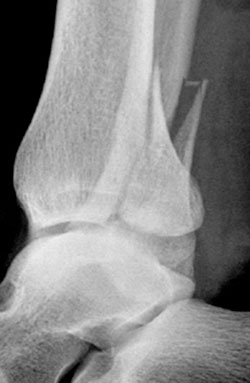Higher BMI and age associated with advanced OA following malleolar fracture
SAN DIEGO — Increased BMI and age over 30 years at the time of surgery are among risk factors for advanced ankle osteoarthritis 12 to 22 years after a malleolar fracture, according to a recent study.
Anne Lübbeke MD, DSc, presented results at the 2011 Annual Meeting of the American Academy of Orthopaedic Surgeons.
Weber C fractures, associated medial malleolus fractures and fracture dislocation all increased the risk as well.
Lübbeke noted long-term studies evaluating risk factors for developing of osteoarthritis (OA) following ankle fracture were “sparse” in the existing literature.
|
|
“Our objective was to identify risk factors for the development of advanced radiologic osteoarthritis 12 to 22 years following surgical treatment of malleolar fracture,” she said.
Lübbeke and colleagues performed a retrospective cohort study, analyzing results from consecutive patients at her institution treated with open reduction and internal fixation (ORIF) for malleolar fractures from January 1988 to December 1997.
Two independent reviewers used standardized radiographs to assess ankle OA. A multivariate logistic regression analysis was done to determine OA predictors.
|
Image: Lübbeke A |
“We collected data on the following potential risk factors for OA: age, gender, body mass index at the time of operation, profession, type of fracture according to Weber classification, presence of fracture dislocation, associated fracture of the medial or posterior malleolus, and time between surgery and follow-up,” Lübbeke said. “We wanted to predict the occurrence of advanced radiologic osteoarthritis evaluated on the Kellgren-Lawrence scale, where grades 3 to 4 are considered advanced osteoarthritis.”
In all, 374 patients, 56% of which were males, underwent surgery during the study period.; 9% of them had a Weber A fracture, 58% sustained a Weber B fracture and 33% sustained a Weber C fracture, Lübbeke noted.
Lübbeke reported that 12 to 22 years after surgery, 47 patients had died, 126 were lost to follow-up and 99 did not participate — leaving 102 patients. They were similar in age, gender, BMI and type of fracture to those patients who were not seen, and had a mean follow-up of 17.3 years.
The group reported advanced OA in 37 patients (36.3%). Significant risk factors identified for advanced OA were fracture type, presence of medial malleolus fracture, fracture dislocation, increasing BMI, older age and longer follow-up time.
“Age over 30 was associated with a substantially higher risk of osteoarthritis,” Lübbeke said. “Increasing BMI also led to a higher probability of developing osteoarthritis. This was statistically significant. Fifty-three percent of patients with a Weber C fracture developed osteoarthritis, compared to 31% of those with a Weber B fracture. Presence of fracture dislocation increased risk by 2, and associated fracture of the medial malleolus increased risk by 2.5.”
Gender, posterior malleolus fracture and profession all had no significant influence on OA development, she added.
“Advanced radiologic osteoarthritis was present in 36% of the patients who underwent treatment for malleolar fractures,” Lübbeke said. This was – to her knowledge – the first study to quantify risk factors inherent to the problem of OA following this type of fracture with a follow-up exceeding 10 years. – by Robert Press
Reference:
- Lübbeke A, Savo D, Holzer N, et al. Risk factors for post-traumatic ankle osteoarthritis: A 12-22 year follow-up study. Paper #91. Presented at the 2011 Annual Meeting of the American Academy of Orthopaedic Surgeons. Feb. 15-19. San Diego.

- Anne Lübbeke, MD, DSc, can be reached at Department of Surgery, HUG, 1211 Geneva 14, Switzerland; email: Anne.Lubbekewolff@hcuge.ch.
- Disclosure: Lübbeke has no relevant financial disclosures.
In contrast to other types of osteoarthritis, there is most often a reason for the development of ankle osteoarthritis. One of these frequent causes is a previous ankle fracture, even when this fracture has an anatomical reduction and fixation. The authors studied a relevant topic in orthopaedic surgery today and defined some predictors for the development of osteoarthritis after an ankle fracture. They defined many predictors in a small group of 37 patients with advanced ankle osteoarthritis. The conclusions are similar to a previous meta-analysis (Injury 2011) from our center. A medial malleolar fracture is an intra-articular (pilon-like) fracture and the associated cartilage damage, as all intra-articular fractures, have a relatively high incidence of causing osteoarthritis in the long term. Weber B fractures result in less osteoarthritis compared to Weber C fractures probably because of the fact that Weber B fractures are caused by an external rotation mechanism and this will cause less compression of the talus against the pilon tibiale compared to ankle fractures caused by an abduction force. It would be interesting if the authors had made a comparison between Weber B fractures without medial (deltoid ligament or medial malleolar fracture) involvement (SER II) which were treated operatively and a group which was treated nonoperatively. It is currently believed that SERII fracture requires no operative intervention without causing more osteoarthritis on long-term compared to the operatively treated SER II fractures.
— Michel P. J. van den Bekerom,
MD
Consultant orthopaedic surgeon
— C. Niek Van Dijk, MD,
PhD
Professor and head of the orthopaedic department Academic Medical
Center,
Amsterdam, The Netherlands
Disclosure: Van den Bekerom
and Van Dijk have no relevant financial disclosures.



